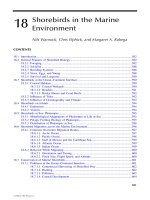Lecture biology (6e) chapter 18 campbell, reece
Bạn đang xem bản rút gọn của tài liệu. Xem và tải ngay bản đầy đủ của tài liệu tại đây (1.57 MB, 88 trang )
CHAPTER 18 MICROBIAL MODELS:
THE GENETICS OF VIRUSES AND
BACTERIA
Section A: The Genetics of Viruses
1.
2.
3.
4.
5.
6.
7.
8.
Researchers discovered viruses by studying a plant disease
A virus is a genome enclosed in a protective coat
Viruses can only reproduce within a host cell: an overview
Phages reproduce using lytic or lysogenic cycles
Animal viruses are diverse in their modes of infection and replication
Plant viruses are serious agricultural pests
Viroids and prions are infectious agents even simpler than viruses.
Viruses may have evolved from other mobile genetic elements
Copyright © 2002 Pearson Education, Inc., publishing as Benjamin Cummings
Introduction
• Viruses and bacteria are the simplest biological
systems - microbial models where scientists find
life’s fundamental molecular mechanisms in their
most basic, accessible forms.
• Microbiologists provided most of the evidence that
genes are made of DNA, and they worked out most
of the major steps in DNA replication, transcription,
and translation.
• Viruses and bacteria also have interesting, unique
genetic features with implications for understanding
diseases that they cause.
Copyright © 2002 Pearson Education, Inc., publishing as Benjamin Cummings
• Bacteria are prokaryotic organisms.
• Their cells are much smaller and more simply
organized that those of eukaryotes, such as plants
and animals.
• Viruses are smaller and
simpler still, lacking the
structure and most metabolic machinery in cells.
• Most viruses are little
more than aggregates of
nucleic acids and protein
- genes in a protein coat.
Fig. 18.1
Copyright © 2002 Pearson Education, Inc., publishing as Benjamin Cummings
1. Researchers discovered viruses by
studying a plant disease
• The story of how viruses were discovered begins in
1883 with research on the cause of tobacco mosaic
disease by Adolf Mayer.
• This disease stunts the growth and mottles plant leaves.
• Mayer concluded that the disease was infectious when he
found that he could transmit the disease by spraying sap
from diseased leaves onto healthy plants.
• He concluded that the disease must be caused by an
extremely small bacterium, but Dimitri Ivanovsky
demonstrated that the sap was still infectious even after
passing through a filter designed to remove bacteria.
Copyright © 2002 Pearson Education, Inc., publishing as Benjamin Cummings
• In 1897 Martinus Beijerinck ruled out the
possibility that the disease was due to a filterable
toxin produced by a bacterium and demonstrated
that the infectious agent could reproduce.
• The sap from one generation of infected plants could be
used to infect a second generation of plants which could
infect subsequent generations.
• Bierjink also determined that the pathogen could
reproduce only within the host, could not be cultivated
on nutrient media, and was not inactivated by alcohol,
generally lethal to bacteria.
• In 1935, Wendell Stanley crystallized the
pathogen, the tobacco mosaic virus (TMV).
Copyright © 2002 Pearson Education, Inc., publishing as Benjamin Cummings
2. A virus is a genome enclosed in a
protective coat
• Stanley’s discovery that some viruses could be
crystallized was puzzling because not even the
simplest cells can aggregate into regular crystals.
• However, viruses are not cells.
• They are infectious particles consisting of nucleic
acid encased in a protein coat, and, in some cases, a
membranous envelope.
• Viruses range in size from only 20nm in diameter to
that barely resolvable with a light microscope.
Copyright © 2002 Pearson Education, Inc., publishing as Benjamin Cummings
• The genome of viruses includes other options than
the double-stranded DNA that we have studied.
• Viral genomes may consist of double-stranded DNA,
single-stranded DNA, double-stranded RNA, or singlestranded RNA, depending on the specific type of virus.
• The viral genome is usually organized as a single linear
or circular molecule of nucleic acid.
• The smallest viruses have only four genes, while the
largest have several hundred.
Copyright © 2002 Pearson Education, Inc., publishing as Benjamin Cummings
• The capsid is a protein shell enclosing the viral
genome.
• Capsids are build of a large
number of protein subunits
called capsomeres, but
with limited diversity.
• The capsid of the tobacco
mosaic virus has over 1,000
copies of the same protein.
• Adenoviruses have 252
identical proteins arranged
into a polyhedral capsid - as
an icosahedron.
Fig. 18.2a & b
Copyright © 2002 Pearson Education, Inc., publishing as Benjamin Cummings
• Some viruses have viral
envelopes, membranes
cloaking their capsids.
• These envelopes are derived
from the membrane of the host
cell.
• They also have some viral
proteins and glycoproteins.
Fig. 18.2c
Copyright © 2002 Pearson Education, Inc., publishing as Benjamin Cummings
• The most complex capsids are
found in viruses that infect
bacteria, called bacteriophages
or phages.
• The T-even phages that infect
Escherichia coli have a 20-sided
capsid head that encloses their
DNA and a protein tail piece that
attaches the phage to the host and
injects the phage DNA inside.
Fig. 18.2d
Copyright © 2002 Pearson Education, Inc., publishing as Benjamin Cummings
3. Viruses can reproduce only within a host
cell: an overview
• Viruses are obligate intracellular parasites.
• They can reproduce only within a host cell.
• An isolated virus is unable to reproduce - or do
anything else, except infect an appropriate host.
• Viruses lack the enzymes for metabolism or
ribosomes for protein synthesis.
• An isolated virus is merely a packaged set of genes
in transit from one host cell to another.
Copyright © 2002 Pearson Education, Inc., publishing as Benjamin Cummings
• Each type of virus can infect and parasitize only a
limited range of host cells, called its host range.
• Viruses identify host cells by a “lock-and-key” fit
between proteins on the outside of virus and specific
receptor molecules on the host’s surface.
• Some viruses (like the rabies virus) have a broad
enough host range to infect several species, while
others infect only a single species.
• Most viruses of eukaryotes attack specific tissues.
• Human cold viruses infect only the cells lining the upper
respiratory tract.
• The AIDS virus binds only to certain white blood cells.
Copyright © 2002 Pearson Education, Inc., publishing as Benjamin Cummings
• A viral infection begins when
the genome of the virus enters
the host cell.
• Once inside, the viral genome
commandeers its host,
reprogramming the cell to copy
viral nucleic acid and
manufacture proteins from the
viral genome.
• The nucleic acid molecules and
capsomeres then self-assemble
into viral particles and exit the
cell.
Fig. 18.3
Copyright © 2002 Pearson Education, Inc., publishing as Benjamin Cummings
4. Phages reproduce using lytic or lysogenic
cycles
• While phages are the best understood of all viruses,
some of them are also among the most complex.
• Research on phages led to the discovery that some
double-stranded DNA viruses can reproduce by two
alternative mechanisms: the lytic cycle and the
lysogenic cycle.
Copyright © 2002 Pearson Education, Inc., publishing as Benjamin Cummings
• In the lytic cycle, the phage reproductive cycle
culminates in the death of the host.
• In the last stage, the bacterium lyses (breaks open) and
releases the phages produced within the cell to infect
others.
• Virulent phages reproduce only by a lytic cycle.
Copyright © 2002 Pearson Education, Inc., publishing as Benjamin Cummings
Fig. 18.4
Copyright © 2002 Pearson Education, Inc., publishing as Benjamin Cummings
• While phages have the potential to wipe out a
bacterial colony in just hours, bacteria have defenses
against phages.
• Natural selection favors bacterial mutants with receptors
sites that are no longer recognized by a particular type of
phage.
• Bacteria produce restriction nucleases that recognize and
cut up foreign DNA, including certain phage DNA.
• Modifications to the bacteria’s own DNA prevent its
destruction by restriction nucleases.
• But, natural selection favors resistant phage mutants.
Copyright © 2002 Pearson Education, Inc., publishing as Benjamin Cummings
• In the lysogenic cycle, the phage genome replicates
without destroying the host cell.
• Temperate phages, like phage lambda, use both
lytic and lysogenic cycles.
• Within the host, the virus’ circular DNA engages in
either the lytic or lysogenic cycle.
• During a lytic cycle, the viral genes immediately
turn the host cell into a virus-producing factory, and
the cell soon lyses and releases its viral products.
Copyright © 2002 Pearson Education, Inc., publishing as Benjamin Cummings
• During the lysogenic cycle, the viral DNA molecule
is incorporated by genetic recombination into a
specific site on the host cell’s chromosome.
• In this prophage stage, one of its genes codes for a
protein that represses most other prophage genes.
• Every time the host divides, it also copies the viral
DNA and passes the copies to daughter cells.
• Occasionally, the viral genome exits the bacterial
chromosome and initiates a lytic cycle.
• This switch from lysogenic to lytic may be initiated
by an environmental trigger.
Copyright © 2002 Pearson Education, Inc., publishing as Benjamin Cummings
• The lambda phage which infects E. coli
demonstrates the cycles of a temperate phage.
Copyright © 2002 Pearson Education, Inc., publishing as Benjamin Cummings
Fig. 18.5
5. Animal viruses are diverse in their modes
of infection and replication
• Many variations on the basic scheme of viral infection
and reproduction are represented among animal
viruses.
• One key variable is the type of nucleic acid that serves as a
virus’s genetic material.
• Another variable is the presence or absence of a
membranous envelope.
Copyright © 2002 Pearson Education, Inc., publishing as Benjamin Cummings
Copyright © 2002 Pearson Education, Inc., publishing as Benjamin Cummings
• Viruses equipped with an outer envelope use the
envelope to enter the host cell.
• Glycoproteins on the envelope bind to specific receptors
on the host’s membrane.
• The envelope fuses with the host’s membrane,
transporting the capsid and viral genome inside.
• The viral genome duplicates and directs the host’s protein
synthesis machinery to synthesize capsomeres with free
ribosomes and glycoproteins with bound ribosomes.
• After the capsid and viral genome self-assemble, they bud
from the host cell covered with an envelope derived from
the host’s plasma membrane, including viral
glycoproteins.
Copyright © 2002 Pearson Education, Inc., publishing as Benjamin Cummings
• These enveloped
viruses do not
necessarily kill
the host cell.
Fig. 18.6
Copyright © 2002 Pearson Education, Inc., publishing as Benjamin Cummings
• Some viruses have envelopes that are not derived
from plasma membrane.
• The envelope of the herpesvirus is derived from the
nuclear envelope of the host.
• These double-stranded DNA viruses reproduce within the
cell nucleus using viral and cellular enzymes to replicate
and transcribe their DNA.
• Herpesvirus DNA may become integrated into the cell’s
genome as a provirus.
• The provirus remains latent within the nucleus until
triggered by physical or emotional stress to leave the
genome and initiate active viral production.
Copyright © 2002 Pearson Education, Inc., publishing as Benjamin Cummings









